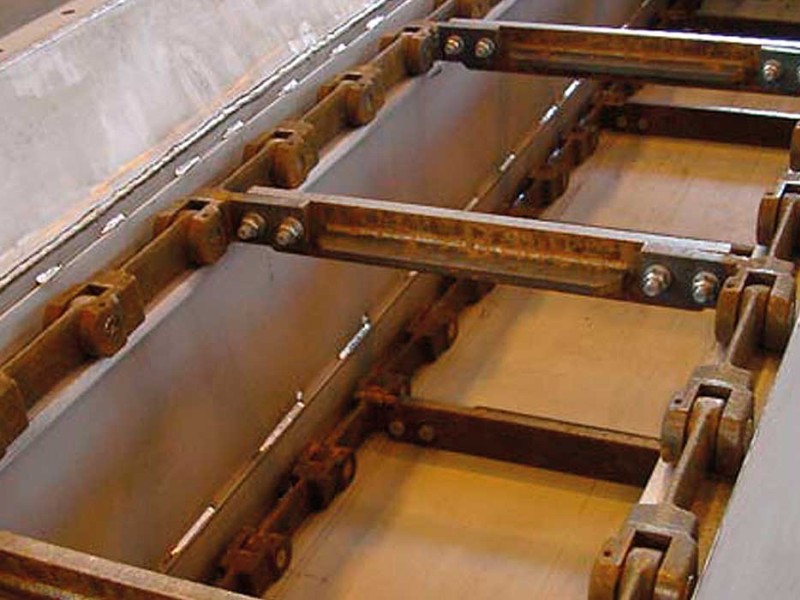Methods for Checking Conveyor Chains with Jammed Rollers

Article content
Signs of Jammed Rollers on Conveyor Chains
Jammed rollers can cause a variety of operational issues, increased wear on the chain to complete system failure. Recognizing the signs of jammed rollers early can help prevent serious damage.
Signs:
-
Unusual noise or squeaking sounds: Jammed rollers often cause grinding, squeaking, or squealing sounds due to friction between the rollers and the chain.
-
Irregular chain movement: If the rollers are not functioning properly, the chain will not move smoothly, leading to jerky or uneven motion.
-
Visible signs of damage: If the roller is visibly misaligned, stuck, or appears damaged, it could be a sign that it’s jammed and causing problems.
Solution:
-
Perform a visual inspection: Check the rollers for any signs of damage or misalignment. If you detect a jammed roller, further investigation is needed to determine the root cause.
.jpg)
Causes of Jammed Rollers in Conveyor Chains
Understanding the root causes of jammed rollers can help you prevent future issues and ensure the chain operates smoothly.
Common causes:
-
Dirt and debris buildup: Dust, dirt, and debris can accumulate around the rollers, causing them to jam or move irregularly.
-
Lack of lubrication: Without proper lubrication, the rollers can experience friction, leading to overheating and eventual jamming.
-
Worn-out rollers: Over time, the rollers can wear out, become bent, or lose their smooth movement, causing them to become jammed.
-
Improper installation: Rollers that are not installed correctly can become misaligned, leading to issues with movement.
Solution:
-
Regular cleaning: Ensure the rollers are cleaned regularly to remove dirt, dust, and other contaminants that may cause jamming.
-
Proper lubrication: Apply the right lubricant to the rollers to reduce friction and prevent them seizing up.
-
Replace worn-out rollers: If the rollers are severely damaged or worn, replace them to prevent further operational issues.
Methods for Checking Jammed Rollers
To prevent issues caused by jammed rollers, it is important to perform regular checks on the conveyor chain and rollers. Here are some methods for identifying jammed rollers.
Methods for checking:
-
Hand testing: Turn off the conveyor system and try moving the rollers by hand. If the rollers do not rotate smoothly or are stuck, they are likely jammed.
-
Sound check: Listen for any unusual grinding or squeaking sounds while the conveyor system is operating. These sounds typically indicate friction due to jammed rollers.
-
Visual inspection: Inspect each roller to see if it is properly aligned with the chain. Look for any obvious damage or misalignment that may indicate a jammed roller.
Solution:
-
Adjust the rollers: If you detect jammed rollers, adjust or realign them to restore smooth movement.
-
Clean and lubricate: Clean the rollers and apply proper lubrication to prevent the problem recurring.
How to Fix Jammed Rollers in Conveyor Chains
Once you identify that a roller is jammed, it is important to take the appropriate steps to fix the issue and prevent further damage to the conveyor system.
Steps to fix:
-
Shut down the system: Ensure the conveyor system is turned off before attempting to address any issues with the rollers.
-
Inspect the jammed roller: Locate the jammed roller and inspect it for any visible signs of damage or blockage. Remove any debris that may be causing the jam.
-
Lubricate the roller: Apply lubrication to the roller to ensure it moves freely without friction.
-
Realign or replace the roller: If the roller is misaligned, adjust its position. If it is severely worn or damaged, replace it with a new roller.
-
Test the system: Once the roller is fixed, run the conveyor system at a slow speed to test the operation of the roller and ensure smooth movement.
Solution:
-
Replace damaged rollers: If the roller is beyond repair, replace it to ensure the system runs efficiently.
Preventing Jammed Rollers in Conveyor Chains
Prevention is always better than dealing with issues after they arise. Implementing regular maintenance and proper care can significantly reduce the risk of jammed rollers.
Preventive measures:
-
Regular cleaning and inspection: Clean the rollers regularly and inspect them for dirt, debris, or wear. Keeping them clean and free of contaminants can help prevent jamming.
-
Proper lubrication: Ensure that all rollers are lubricated properly to reduce friction and prevent them becoming stuck.
-
Monitor operational conditions: Keep track of the conditions in which the conveyor system operates. For example, if the system is exposed to harsh environments, you may need to install additional protective measures to prevent contaminants affecting the rollers.

Conclusion
Jammed rollers on industrial conveyor chains can lead to significant operational issues, including increased friction, uneven chain movement, and system downtime. Identifying the signs of jammed rollers early and taking prompt action can help prevent more serious problems. Regular cleaning, lubrication, and inspection are key to maintaining smooth conveyor chain operation. By taking these steps, you can extend the lifespan of your conveyor system and reduce the need for costly repairs.
If you need more advice on checking and maintaining industrial conveyor chains, feel free to contact us for detailed support!



AAdministratorsQTV
Welcome. Feel free to leave a comment, we will respond soon